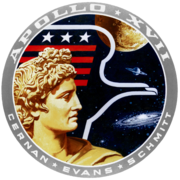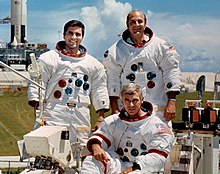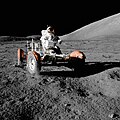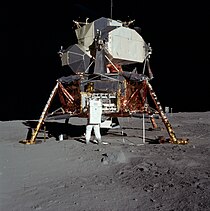Apollo 17 - Simple English Wikipedia, the free encyclopedia
 The Saturn V rocket carrying the Apollo 17 crew into space. | |
| Mission type | Crewed lunar landing |
|---|---|
| Operator | NASA |
| COSPAR ID | 1972-096A |
| SATCAT no. | 06300 |
| Spacecraft properties | |
| Spacecraft | |
| Manufacturer |
|
| Crew | |
| Crew size | 3 |
| Members | |
| Orbital parameters | |
| Reference system | Selenocentric |

| |
| Docking | |
| ing | |
| | |
Apollo 17 was the last flight to send people to the moon. It was done by NASA, the American space group.
It went up to space on December 7, 1972, carrying three astronauts: Eugene Cernan, Harrison Schmitt and Ronald Evans. On December 11, 1972, Cernan and Schmitt became the last humans to land on the moon, while Evans stayed in orbit around the Moon.
The Flight
[change | change source]Going to and from space
[change | change source]About 500,000 people viewed the flight of Apollo 17. A Saturn V rocket took flight from the Kennedy Space Center in America. About two hours after leaving Earth the section with the people in it went away from the main rocket. The section with the people in it had two parts, the Apollo Command Module called America and the Apollo Lunar Module called Challenger. America was the moon control space ship and Eagle was the moon-landing space ship. 3 days later the team entered Lunar Orbit (orbit around the moon). A day later the Challenger went away from America. The Challenger landed safely on the moon with Eugene Cernan and Harrison Schmitt inside.
Photos
[change | change source]- Apollo 17 astronauts (left to right): Harrison Schmitt, Eugene Cernan and Ronald Evans.
- The Saturn V rocket waiting for launch.
- The Blue Marble as photographed by Apollo 17.
- Eugene Cernan as photographed by Harrison Schmitt.
- Eugene Cernan on the Lunar Rover.


 French
French Deutsch
Deutsch






